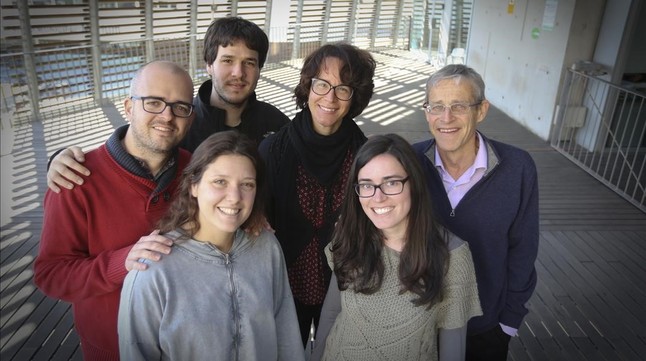
Pollution produces up to a month late in school
This is by a collaborator Jordi Sunyer.
Pollution produces up to a month late in school
Study finds a small slowdown in the brain of children affected in BCN
Experts call for reducing traffic and protect schools pollution

DANNY CAMINAL
BREATHE part of the project team. Front row, Cecilia Percavento and Monica Lopez. Back row, left to right, Joan Forns, Mikel Esnaola, Mar Alvarez and Jordi Sunyer
 MICHELE CATANZARO mcatanzaro
MICHELE CATANZARO mcatanzaro
SUNDAY, FEBRUARY 21, 2016 – 12:35 CET
The difference in capabilities between a 9 year old boy and a 9 years and one month is small. However, if all the students of a school are behind one month, that is a big problem and even a cost. A delay in some capacity 1.1 months separates the school from 25% ofschools most contaminated of Barcelona of 25% of the least polluted. This estimate is derived from a study published last week in the journal Neuroimage ‘.

recommendations
BREATHE study experts have drawn up and submitted to the Education Consortium of Barcelona a series of recommendations each school can apply, regardless of the recommendation at the city level to drastically reduce traffic: if cars pass over 150 meters of a school, the number of particles that reach is ten times lower.
1) Clean when the school is empty, and with the windows open (contaminant particles take up to two hours away).
2) Periodically clean sand playgrounds.
3) Turn off the engine of school buses and cars parked in front of schools.
4) Incorporate particulate filters on school buses.
5) promote active and public transportation, such as school zones.
6) Avoid classes that directly overlook the busy streets or artificially ventilate.
7) Experiment with ‘green wall’ of trees and plants that can stop some of the particles.
The study monitored by MRIbrain 263 students between 8 and 12 years of 39 schools in Barcelona. They were also measured their skills in exercises memory, attention and speed of response. These results were compared to thelevel of contamination of school for each child. By statistical methods they were eliminated the effects of other factors such as social class, noise exposure, the quality of food or the presence of alcohol or smoking in the family. The effect of pollution on the images resonance was a slower reaction to stimuli, which corresponded to a slower development of the exercises.
REACTION SPEED
The rate of reaction of pupils increases as they grow.Pollution hinders the increase, according to the study, producing a delay equal to one month among the most exposed and less exposed students. This was estimated Jordi Sunyer, researcher at the Centre for Research in Environmental Epidemiology (CREAL), coordinator of work withJesus Pujol , the Hospital del Mar, under the BREATHE project, which investigates the effect of air quality in learning . The estimate is contained in a paper being published based on data from the published study.
“Do not think that the more exposed children will have worse outcomes. The individual effects are imperceptible. However, theoverall effect can be significant: in the presence of genetic predisposition, contaminants may increase the risk of certain neurodevelopmental disorders, “says Anna Sans , a pediatric neurologist and coordinator of the unit of learning disabilities in the Sant Hospital Joan de Deu, not involved in the study. “This situation reminds closely the removal of lead from gasoline, which also caused small individual effects. If you move an entire community of 1.1 months down, the impact in terms of educational support or decreased brightest students is great, “Sunyer said.
POLLUTION AND BRAIN ACTIVITY
The researchers measured the pollution in 2012 and 2013 by means of instruments installed in playgrounds and classrooms . “Almost all of the pollution depends on car traffic, except in areas around the harbor,” says Sunyer. The brain of the students was monitored while receiving stimuli such as pictures and music. “Brain activity was developing more slowly in children of the most polluted schools,” explains the researcher. A children themselves, he raised tests like watching fish group photos with one click and determine in which direction the center looked at the fish. In these tests it looked slowdown.
“The results are consistent with previous studies with MRI: two adults and one child in New York,” Sunyer said. It is unknown whether these effects are irreversible. The New York study detected even injury in the brain, but took into account the prenatal exposure. “The impact of pollution in the early years could be more enduring than at school age” scientific adventure.
Reduce traffic
The good news is that you can do something. “The city often exceeds pollution levels set by the EU,” Sunyer, who believes that observesreduce traffic is essential. There are also unilateral measures that can be taken by schools. “In the contract for maintenance of 2016 have introduced a specific provision to renew the sand [trapping particulate pollutants],” says Berta Argany , spokesman for the Education Consortium of Barcelona. “We have also recommended a school bus companies to turn off engines in front of the schools,” he explains.
“The study is further evidence of a public health problem of the first order we ask that measures to address it are accelerated. Should not be a subject of political divergence” says Cristina Ribas , mirmbro the Plataforma per la Qualitat de l ‘ Air.
Traffic noise increases the risk of hyperactivity
The other form of pollution caused by cars, noise also affects the school, according to a study published by Joan Forns of CREAL, along with other scientists, last year. The study, also based on the method of BREATHE project, found that students in the noisiest schools have 27% higher risk of attention deficit disorder and hyperactivity.



It’s concerning to see how pollution can set students back academically. Measures like Psychology Assignment Help can provide crucial support. It’s time to prioritize environmental health in schools for a better learning environment.